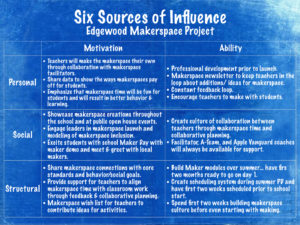
Influencing Change: The Edgewood Makerspace Project
Overview
Research overwhelmingly shows that the way we often teach students is completely wrong for the way students learn, and can sometimes be detrimental to student achievement by removing their agency in learning. Ask any teacher and you will most likely find that the current hyper-focus on testing and packaged curricula isn’t really working for anyone — students OR teachers. But how do we change the system, especially when nobody’s asking students or teachers what is and is not working in classrooms? And how do we support teachers to change the way they teach, when it’s easier to just keep on doing what they’ve been doing?
According to Dr. Jenni Cross in her TEDx talk titled “Three Myths of Behavior Change — What You Think You Know But Don’t”, we must first changebehaviors if we want to change attitudes (Cross, J., 2013). Creating better learning opportunities, even small ones, will help set the attitudes we need to embrace larger changes in the way we teach and learn. In Influencer, Joseph Grenny suggested that focusing on three vital behaviors, using six sources of influence will improve the odds of creating lasting change within an organization (Grenny, J., 2013). My plan is to use Grenny’s Influencer model, along with Cross’s strategy of changing attitudes through changing behaviors to create lasting change within my own school through my Innovation Plan.
Goal
To create a makerspace at Edgewood Elementary that will provide students with collaborative, weekly, student-led, creative learning experiences to reinforce core subject learning in the classroom.
3 Vital Behaviors
- Teachers need to collaborate with co-teachers and Maker Team to plan makerspace offerings and reflect on makerspace experiences.
- Teachers need to act as facilitators in the makerspace, not answer-givers, and become makers, themselves.
- Administration needs to promote and model makerspace facilitation and spotlight makerspace successes.
Targeted Behaviors For Change
- Technology use is mostly centered around consuming content created by others rather than creating content to communicate learning.
- Not much collaboration between teachers, even within the multi-classroom “pods.”
- Not enough time spent on reflection for teachers or for students.
Six Sources of Influence
How Will Change Be Measured
We will measure change by collecting student reflection and creative work, and analyzing it for evidence of deeper learning. We will also use it to constantly revise our makerspace and provide better materials for the makerspace. We will also use a collaborative document for planning the makerspace offerings and ensuring that they align to educational standards being taught in the classrooms, especially in core-subject areas. The collaborative document is meant to encourage collaboration between classroom teachers and the makerspace facilitators, but my hope is that it will also promote collaboration between classroom teachers, and I will facilitate that through scheduling groups with similar learning goals to use the makerspace together.
Organizational Influencers
All faculty at Edgewood Elementary can be influential in making this program work. The administration can be extremely helpful in supporting this innovation plan by ensuring that the scheduling of classroom time will support adequate time for students to ideate, experiment, create, reflect, and revise. The administration would also be very helpful in supporting this initiative by reinforcing participation in the makerspace and providing spaces to showcase makerspace creations throughout the school and during open house events. Another group that could be very influential is our Apple Professional Learning team (AKA the A-Team.) The A-Team meets with teachers regularly to ensure that teachers are integrating technology into their teaching/learning in the most effective ways, and this team could also help teachers to integrate the makerspace into their classroom planning, so that the makerspace time becomes a continuation of classroom learning. Within our school, we have some Apple Vanguard Coaches that have also been trained to provide support with facilitation of technology learning from within the school. These coaches could be valuable support for teachers who are reluctant to use the makerspace, or just need some assistance in figuring out how to integrate it into their weekly planning.
Positive Deviants
Another group that would be influential in this plan is the grades 4/5 pods. This group is already engaging in some Project-Based Learning (PBL) and could integrate the makerspace much in the same way they’re already doing PBL work. This group is typically more open to new ideas, and will be influential in showing other teachers how this space can be used to promote student success. Another positive deviant is Kerry Felton, one of the kindergarten teachers. She uses technology in creative ways and is very open to new ideas. She will enjoy using the makerspace, and seeing how it can be used with younger students would help the teachers of older students feel confident about incorporating the space into their learning.
Resources:
Cross, J. (2013, March 20). Three Myths of Behavior Change – What You Think You Know That You Don’t: Jeni Cross at TEDxCSU. Retrieved October 15, 2016, from https://www.youtube.com/watch?v=l5d8GW6GdR0
Grenny, J. (2013). Influencer: The new science of leading change. New York: McGraw-Hill Education.
